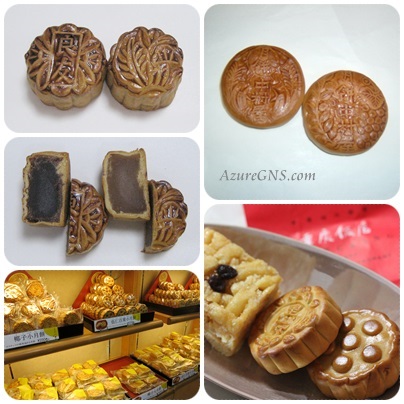Wagaya no O-tsuki-mi;
Our Moon Viewing Experience
十五夜には月見団子と秋の野菜や果物が月にお供えされます。月見団子は白く丸い団子を重ねたものや、餡で覆われたもの、串に刺したものなど、地方によって様々です。すすき、桔梗、菊などの秋の花も月にお供えされます。
On Jugo-ya (a Moon Viewing Night) tsuki-mi-dango (moon viewing dumplings), autumn vegetables and fruits are offered to the moon. Tsuki-mi-dango varies by region such as a pile of round white dumplings, dumplings covered with anko (sweetened bean-paste) or dumplings on a skewer. Autumn flowers such as Japanese bellflowers, Japanese pampas grass and chrysanthemums are also offered.
月の模様は国によって見え方が違うようです。アメリカでは横向きの女性、ヨーロッパでは蟹、中東ではライオンなど、南米ではワニ、中国ではヒキガエルなどです。日本ではウサギが餅をついているという言い伝えがあります。そのため、十五夜が近づくと月のウサギをかたどった和菓子がいろいろ販売されます。我が家では餡が入ったお饅頭をよく買います。
Each country identifies the markings of the moon in its own way; for example, a side view of a woman in the USA, a crab in Europe, a lion in the Middle East, an alligator in South America and a toad in China. In Japan, the folklore says that a rabbit is pounding steamed rice to make mochi on the moon. When Jugo-ya comes up, various rabbit-shaped sweets are sold. We often buy a rabbit-shaped O-manju (a Japanese style steamed bun) stuffed with anko.
中国では十五夜に親しい人やお世話になった人に月餅を贈り、食べる習慣があります。私の子供の頃、我が家と親しくしていた近所の中国人のご一家から上等な月餅を何度か頂きました。私はその頃から月餅が大好きで、横浜や神戸の中華街に行くたびに月餅を買って帰ります。
In China on Jugo-ya, they have the custom of presenting geppei (a moon biscuit or a mooncake) as a gift to people who are close to them or take care of them. When I was a child, my family was friendly with a nearby Chinese family, and several times they gave us great geppei. Since then, I have loved geppei and buy some geppei every time I go to the Chinatowns in Kobe and Yokohama.
我が家の愛犬のふーちゃんもおーちゃんも当然のことながら、月より団子に興味があります。まだ10ヶ月のおーちゃんは月見団子を凝視していましたが、突然テーブルに飛び乗ってお団子を食べてしまいました。
Naturally, our beloved dogs, Fu-chan and Oh-chan, were more interested in the dumplings than the moon. Oh-chan, at the age of only ten months was gazing at tsuki-mi-dango, suddenly jumped on the table and ate some of the dumplings.
2013年(平成25年)9月、東京都墨田区の向島百花園の月見の会へ家族と行きました。月見団子、野菜、果物、すすきなどの正式な十五夜飾りがお月様に供えられていました。観月とともに、茶会、琴の演奏、絵灯籠の点灯式などのイベントを楽しみました。この庭園は1804年(文化元年)に仙台出身の骨董商だった佐原鞠塢(さはらきくう)により、民営の花園として開園しました。最初は360本の梅が植えられ、その後、日本の古典文学にゆかりのある様々な植物が植えられました。1938年(昭和13年)、庭園は東京に寄付され、翌年に有料の公営公園となりました。1945年(昭和20年)3月の東京大空襲により庭園も園内の趣のある建物も全焼しましたが、1949年(昭和24年)に再開されました。1978年(昭和53年)に文化財保護法により、国の史跡および名勝に指定されました。
In September 2013 (Heisei 25th yr), my family and I went to Mukojima Hyakka-en Park in Sumida Ward, Tokyo for the Moon Viewing Festival. Tsuki-mi-dango, vegetables, fruits and Japanese pampas grass were formally offered to the moon as Jugo-ya-kazari (a full moon decoration). We enjoyed various events such as a tea ceremony, the concert of koto (a long Japanese musical instrument having 13 strings resembling a horizontal harp) and the lighting event of lanterns with pictures painted on as well as moon viewing. This was opened as a private garden in 1804 (Bunka 1st yr) by Sahara Kikuu who had formerly been an antique dealer from Sendai. At first, 360 trees of ume (a Japanese apricot) were planted, and gradually various seasonal flowers have been planted, mainly flowers with a close connection to Japanese ancient literature. In 1938 (Showa 13th yr), the garden was donated to Tokyo, and Tokyo opened the garden to the public for an entrance fee the year after. In March 1945 (Showa 20th yr), both the garden and its refined buildings were burnt down during the Great Tokyo Air Raid, but in 1949 (Showa 24th yr) the garden was reopened. Since 1978 (Showa 53rd yr), this garden has been designated as a beautiful national historic site under the Act on Protection of Cultural Properties.
2015年(平成27年)、四国の愛媛県へ家族と行きました。ちょうど中秋の名月の日でしたので、松山城ロープウェイの駅には月見団子、里芋、栗などが供えられていました。ポスターによると、夜には「お城と月の物語」という観月のイベントが城内やその周辺で開催されるようでした。松山城は1603年(慶長7年)に加藤嘉明が築きました。1784年(天明4年)に落雷により焼失しましたが、1854年(安政元年)、第12代藩主の松平勝善が再建しました。その後、放火、失火、空襲などにより、大天守以外は何度か焼失しましたが現在はほとんどが再建されています。日本の現存12天守の1つの大天守は国の重要文化財に指定されています。その他、日本100名城、日本の歴史公園100選、日本さくら名所100選に選定されています。2009年(平成21年)のミシュランガイド日本の観光地編において松山城は2つ星を獲得しました。
In 2015 (Heisei 27th yr), my family and I went to Ehime Prefecture on Shikoku Island. It was on the day of Chushu-no-meigetsu (the harvest moon) that tsuki-mi-dango, taros and chestnuts were offered at Matsuyama-jo Castle Ropeway Station. According to the poster, the moon viewing festival with the title of “O-shiro to Tsuki-mi no Monogatari” (The Tale about the Castle and moon viewing) would be held at and around the castle on the night. In 1603 (Keicho 7th yr), Matsuyama Castle was originally constructed by Kato Yoshiaki. In 1784 (Tenmei 4th yr), the castle was struck by lightning and burned down, and in 1854 (Ansei 1st yr), the 12th feudal lord, Matsudaira Katsuyoshi reconstructed it. Later, the castle except for Dai-tenshu (the great keep or the great castle tower) burned down several times due to arson, accidental fires and air raids, but most parts of the castle are now reconstructed. The Dai-tenshu, one of the existing 12 castle towers, is designated as a national important cultural property. In addition, the castle was selected as one of Japan’s Top 100 Castles, one of Japan’s Top 100 historical parks and one of Japan’s Top 100 Cherry Blossom Viewing Sites. In 2009 (Heisei 21st yr), this castle was awarded two stars in the Michelin’s Practical Guidebook for Travelling Japan, also known as Michelin’s Green Guide Japan.
2016年9月に夫と一緒に夫の祖父母のお墓参りの後、近くの生田緑地の岡本太郎美術館に立ち寄りました。そして、同じ公園内にある、日本の古民家を集めた野外博物館である日本民家園に入りました。重要文化財9棟、重要有形民俗文化財1件を含む、日本中から集められた20数棟が展示されています。9月半ばといえどもまだまだ蒸し暑く、広い敷地内をふらふらになりながら歩きました。そんな疲れが癒やされたのが、趣のある民家の縁側にお供えされた伝統的な十五夜飾りでした。その日は十五夜で、すすき、月見団子、里芋、さつま芋、柿、栗、大根が並べられていました。夜には十五夜飾りの解説や観月のイベントが開催されるようでしたが、残念ながら家で留守番をしている愛犬のため夜までに帰宅しなければいけないので参加することはできませんでした。
In September 2016, after my husband and I visited his grandparents’ grave, we dropped by the Okamato Taro Museum of Art which was nearby. Afterward we visited Nihon Minka-en in the same park. Minka-en is an outdoor museum of more than 20 traditional minka (private houses), including 9 important cultural properties and 1 important tangible folk-cultural property from various places in Japan. It was still hot and humid even in the middle of September and I exhaustedly walked around the extensive grounds. I felt better when I saw traditional Jugo-ya-kazari on engawa (Japanese-style wooden or bamboo verandas) of houses with a wonderful atmosphere. It was Jugo-ya, so Japanese pampas grass, tsuki-mi-dango, taros, sweet potatoes, persimmons, chestnuts and daikon (Japanese radishes) were arranged there. Although a lecture of Jugo-ya-kazari and a moon-viewing event were held that night, we couldn’t join them because we had to go home before the evening for our beloved dogs who were waiting for us.
(「お月見」へ戻ります)
(Back to “The Moon Viewing”)
Copyright (C) Azure Global Network Services. All Rights Reserved.





